This guide describes how to install a Grafana Loki instance with Event Exporter and Promtail on a local Kubernetes Cluster (using KinD).
First you will install Docker on Windows, then deploy a Kubernetes Cluster on Docker using Kind. After that you will install Grafana Loki and Event Exporter and Promtail. The last step is executing a Loki query and admire your results!
The solutions used in this guide are:
| Solution | Functionality |
|---|---|
| Docker | A platform for developing, shipping, and running applications inside lightweight, isolated containers. |
| Kubernetes | An open-source system for automating the deployment, scaling, and management of containerized applications. |
| Kubectl | A command-line tool to interact with and manage Kubernetes clusters. |
| Kind | A tool to run local Kubernetes clusters using Docker containers for easy testing and development. |
| Helm | A package manager for Kubernetes, enabling easier application deployment and management using reusable charts. |
| Prometheus | An open-source monitoring and alerting toolkit designed for reliability and scalability in cloud environments. |
| Grafana Loki | A log aggregation system designed to work with Grafana for querying, visualizing, and alerting on logs. |
| Kubernetes Event Exporter | A tool for exporting Kubernetes events to various logging and monitoring backends. |
| Promtail | An agent that collects logs and forwards them to Loki for centralized log management and querying. |
Prerequisites
Install Docker for Windows
https://docs.docker.com/desktop/install/windows-install

Get kubectl
Download kubectl (for Windows) and copy to: c:\k8s
Install Kind
Download Kind (for Windows) and move to c:\k8s\kind\kind.exe
Don’t forget to add the file extension .exe
Quick guide available here: https://kind.sigs.k8s.io/docs/user/quick-start/
Add path to system environment variable
Add c:\k8s\kind to environment variable Path.
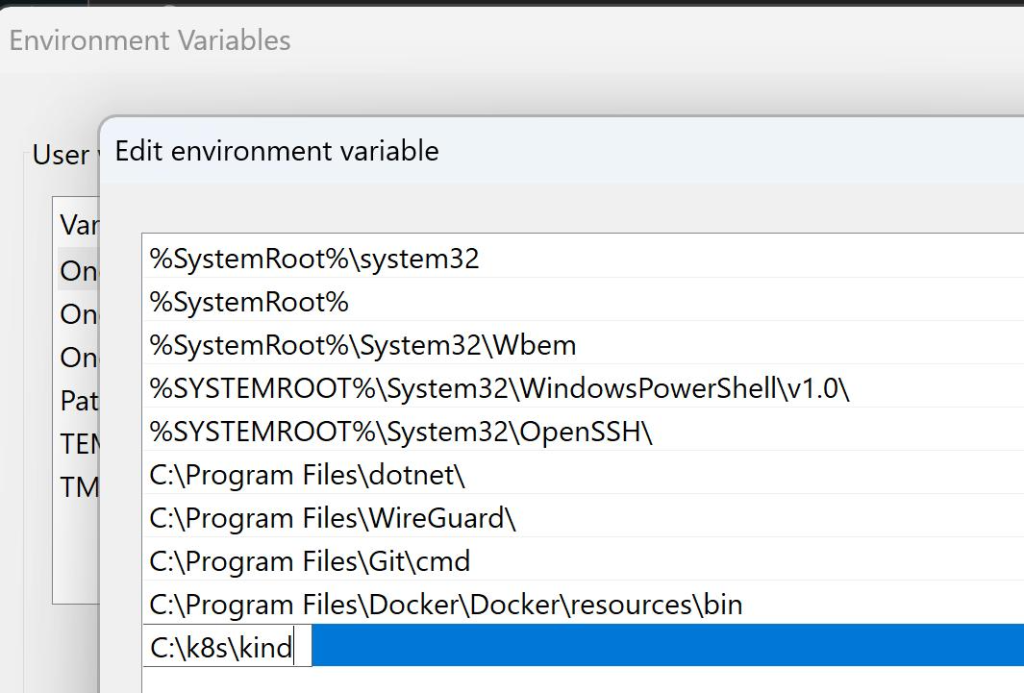
Create Kubernetes Cluster
Configures and starts a K8s cluster using KinD on the local machine.

Create kind.yaml
c:\k8s\kind.yaml
# This config file contains all config fields with comments
kind: Cluster
apiVersion: kind.x-k8s.io/v1alpha4
# 1 control plane node and 3 workers
nodes:
# the control plane node config
- role: control-plane
# the three workers
- role: worker
- role: worker
- role: worker
cd c:\k8s
kind create cluster --config kind.yaml --name k8s-lab
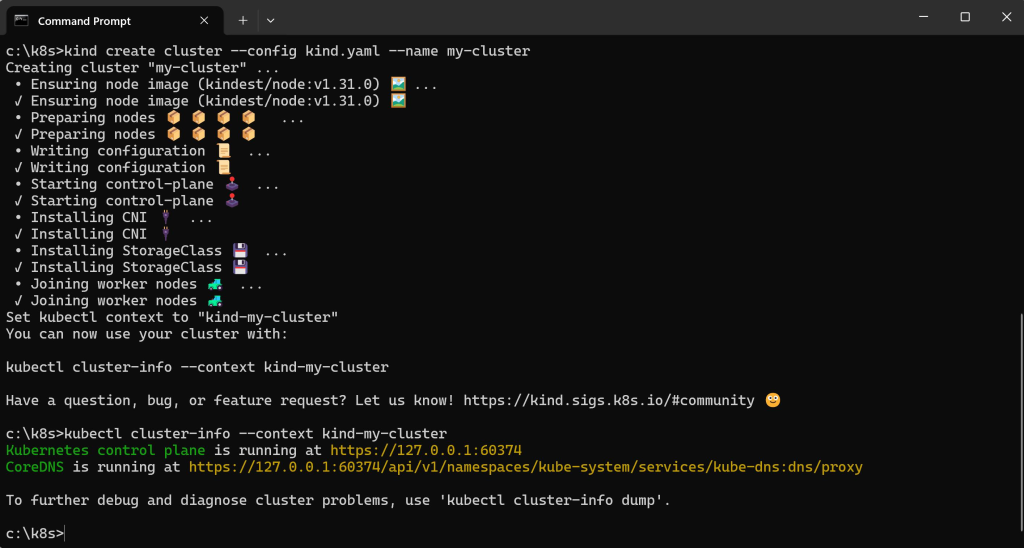
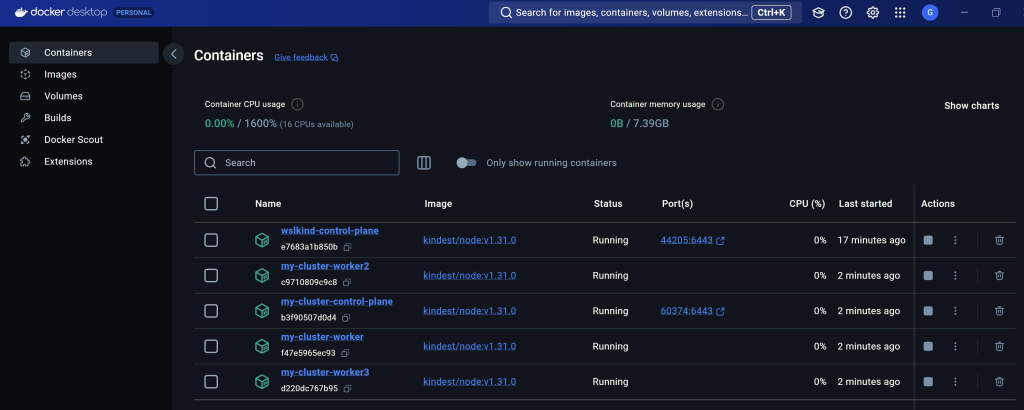
Install Helm
Role: used to install helm charts (k8s templates)
https://helm.sh/docs/intro/install
winget install Helm.Helm
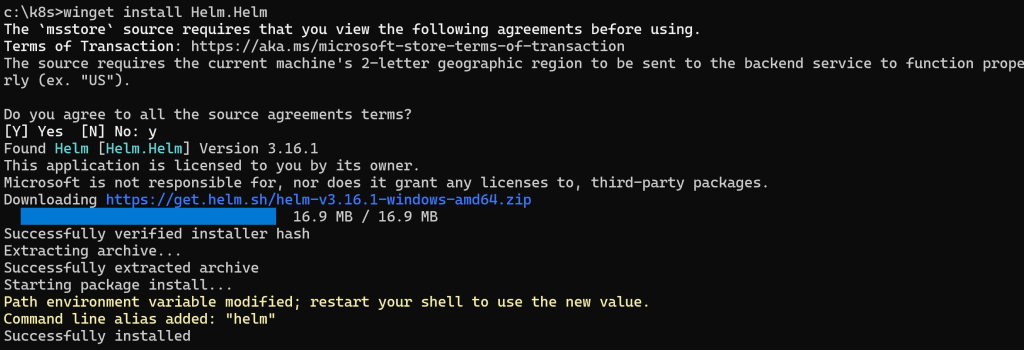
Could be you have restart cmd.exe to make Helm available/working
Deploy Prometheus
Add repository
helm repo add prometheus-community https://prometheus-community.github.io/helm-charts
helm repo update
Install
kubectl create namespace prometheus
helm upgrade --install prometheus prometheus-community/kube-prometheus-stack -n prometheus
Get status
kubectl get services --namespace prometheus
kubectl --namespace prometheus get pods -l "release=prometheus"
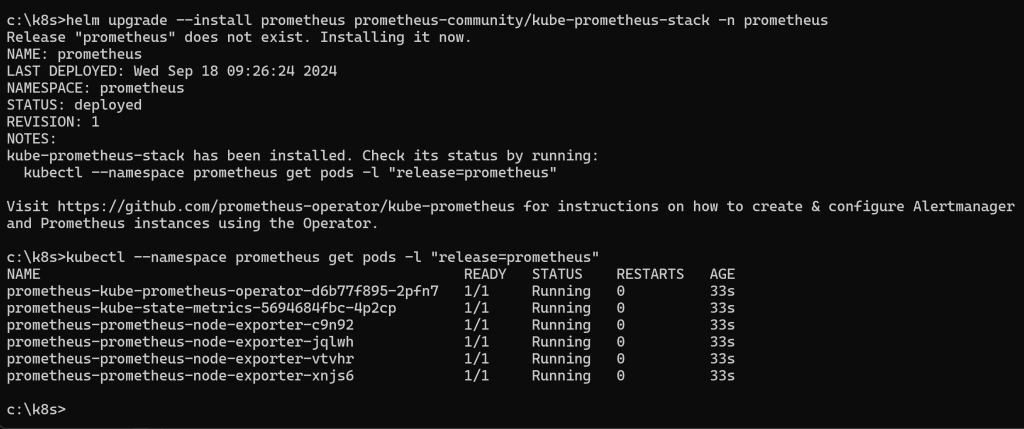
Port forward
Forward port 3000 from local host to Grafana container by starting a new Command Prompt and execute the following command. Leave this windows open, the port forwarding will be cancelled when you close the window.
kubectl port-forward deployment/prometheus-grafana -n prometheus 3000

Open browser and browse to: http://localhost:3000/login
Default credentials:
User: admin
pass: prom-operator
Default User/Password is defined in chart

Deploy Grafana Loki
Add repository
helm repo add grafana https://grafana.github.io/helm-charts
helm repo update
loki.yaml
c:\k8s\loki.yaml
loki:
schemaConfig:
configs:
- from: 2024-04-01
store: tsdb
object_store: s3
schema: v13
index:
prefix: loki_index_
period: 24h
ingester:
chunk_encoding: snappy
tracing:
enabled: true
querier:
# Default is 4, if you have enough memory and CPU you can increase, reduce if OOMing
max_concurrent: 4
auth_enabled: false
#gateway:
# ingress:
# enabled: true
# hosts:
# - host: FIXME
# paths:
# - path: /
# pathType: Prefix
deploymentMode: SimpleScalable
backend:
replicas: 3
read:
replicas: 3
write:
replicas: 3
# Enable minio for storage
minio:
enabled: true
# Zero out replica counts of other deployment modes
singleBinary:
replicas: 0
ingester:
replicas: 0
querier:
replicas: 0
queryFrontend:
replicas: 0
queryScheduler:
replicas: 0
distributor:
replicas: 0
compactor:
replicas: 0
indexGateway:
replicas: 0
bloomCompactor:
replicas: 0
bloomGateway:
replicas: 0
Install
kubectl create namespace loki
helm install --values loki.yaml loki --namespace=loki grafana/loki
Get status
kubectl get services --namespace loki
kubectl --namespace loki get pods -l "release=loki"
Configure Loki Datasource
URL: http://loki-gateway.loki.svc.cluster.local/
This is the name of the container loki-gateway.
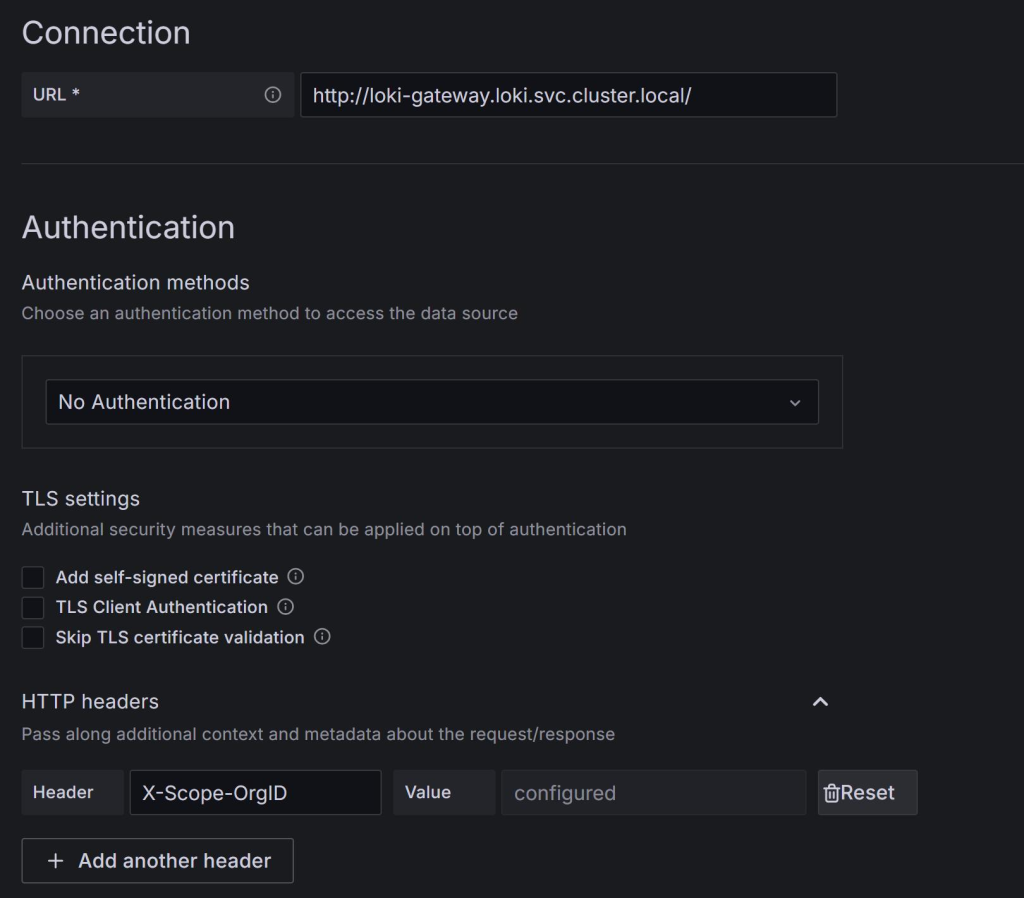
Deploy Kubernetes Event Exporter
Role: Forwards all Kubernetes Events to Loki
Add repository
helm repo add bitnami https://charts.bitnami.com/bitnami
eventexporter.yaml
c:\k8s\eventexporter.yaml
config:
leaderElection: {}
logLevel: debug
logFormat: pretty
metricsNamePrefix: event_exporter_
receivers:
- name: "dump"
file:
path: "/dev/stdout"
layout: {}
- name: "loki"
loki:
url: "http://loki-gateway.loki.svc.cluster.local/loki/api/v1/push"
streamLabels:
source: kubernetes-event-exporter
container: kubernetes-event-exporter
route:
routes:
- match:
- receiver: "dump"
- receiver: "loki"
Install
kubectl create namespace event-exporter
helm install event-exporter bitnami/kubernetes-event-exporter --values eventexporter.yaml --namespace=event-exporter
Get Status
kubectl get all -l app.kubernetes.io/name=kubernetes-event-exporter --namespace event-exporter
Deploy Promtail
Role: Forward all logging from/in containers to Loki
promtail.yaml
c:\k8s\promtail.yaml
config:
# publish data to loki
clients:
- url: http://loki-gateway.loki.svc.cluster.local/loki/api/v1/push
tenant_id: 1
Install
kubectl create namespace promtail
helm upgrade --values promtail.yaml --install promtail grafana/promtail --namespace promtail

Sample Loki Queries
In a later post I will elaborate on querying but for now I’ll show you two basic queries:
Open Grafana, and start “Explore”, Set to code.

/// Query all Kubernetes events
{source="kubernetes-event-exporter"} |= ``
/// Query all logs that contain "error", for all running containers
{container=~".+"} |= "error"
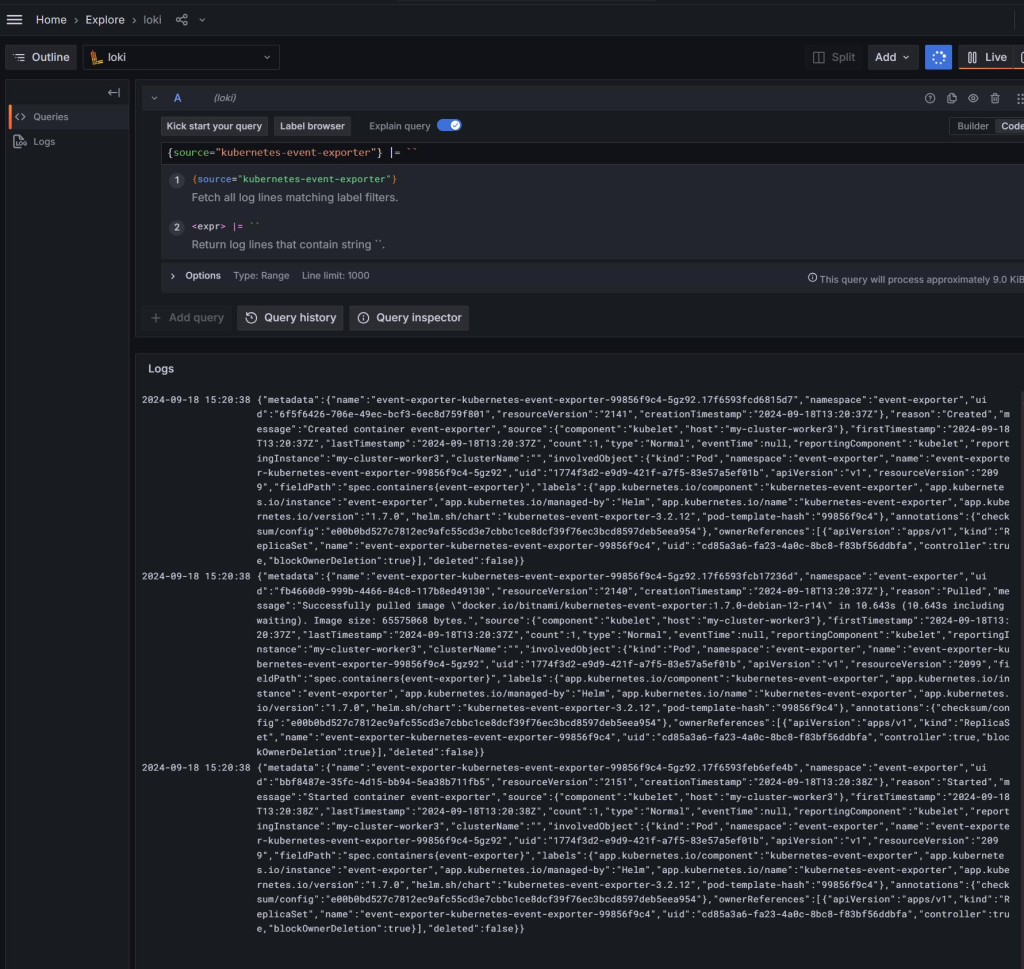
Removing and Uninstalling
The commands to remove or uninstalling the various components are:
Uninstall components
helm uninstall event-exporter
helm uninstall loki
helm uninstall promtail
Delete the Kubernetes Cluster
kind delete cluster <name of your cluster>


